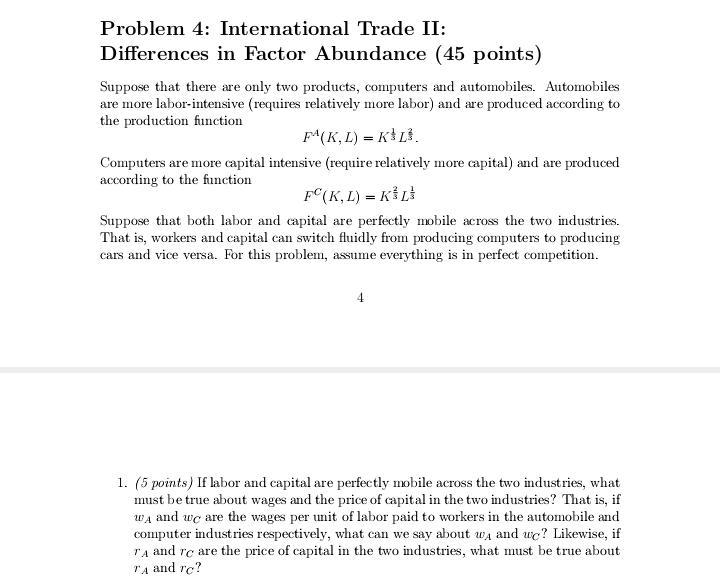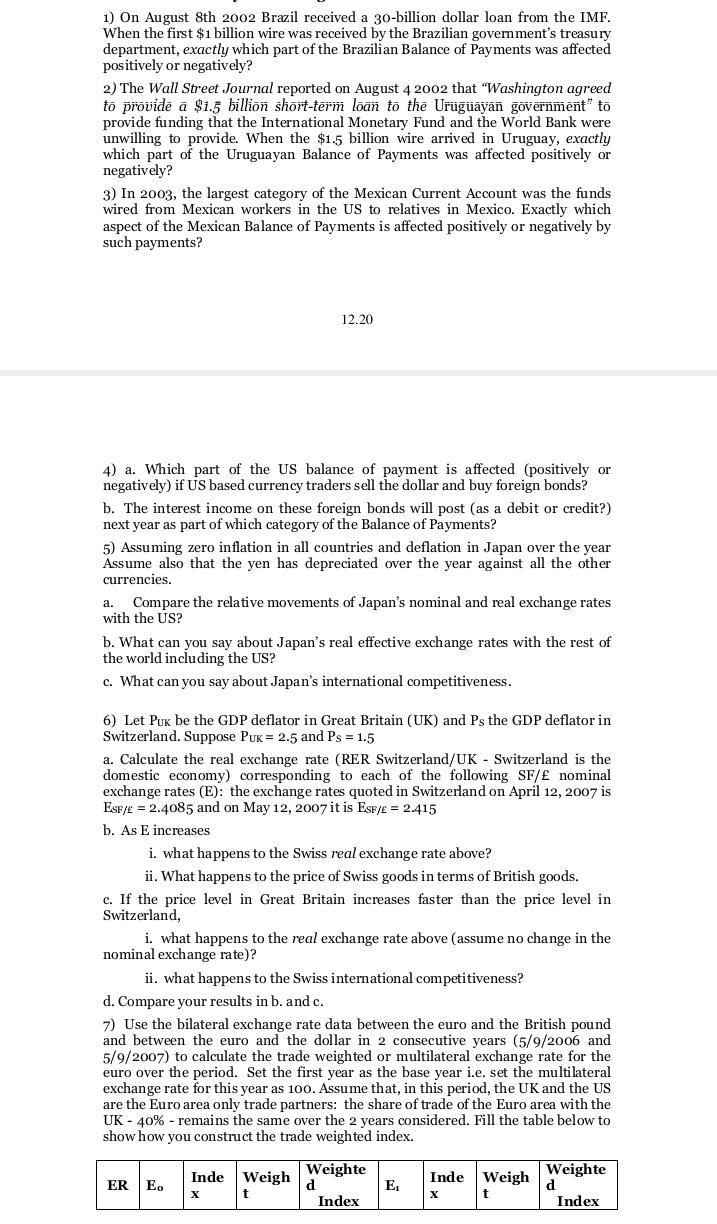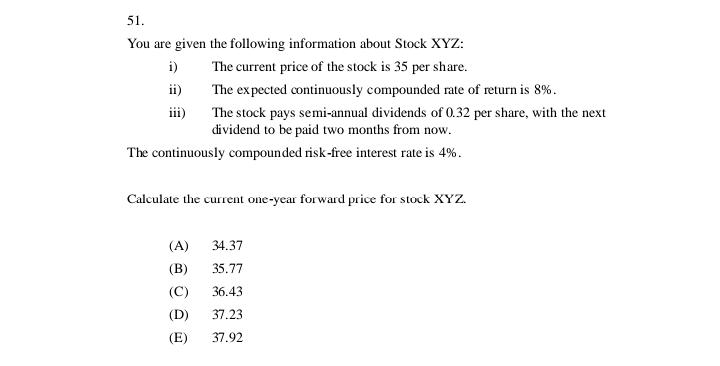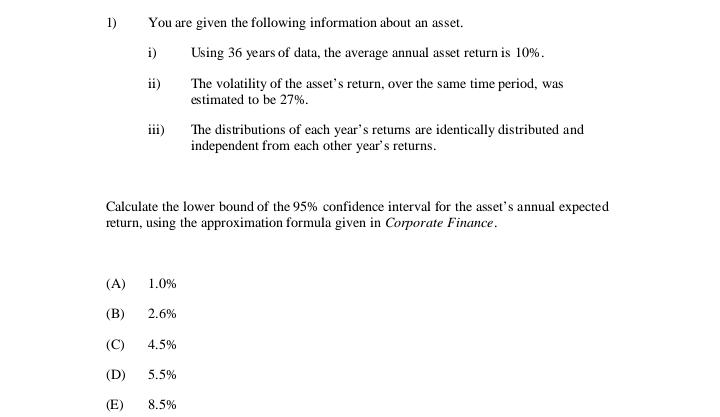






Help help plz.
2. What is precautionary saving? What assumptions are needed for precautionary savings to arise? Does precautionary saving resolve some empirical puzzles in consumption behavior?Problem 4: International Trade II: Differences in Factor Abundance (45 points) Suppose that there are only two products, computers and automobiles. Automobiles are more labor-intensive ( requires relatively more labor) and are produced according to the production function FA( K, L) = KILL. Computers are more capital intensive (require relatively more capital) and are produced according to the function F"(K, L) = KILI Suppose that both labor and capital are perfectly mobile across the two industries. That is, workers and capital can switch fluidly from producing computers to producing cars and vice versa. For this problem, assume everything is in perfect competition. 1. (5 points) If labor and capital are perfectly mobile across the two industries, what must be true about wages and the price of capital in the two industries? That is, if wA and we are the wages per unit of labor paid to workers in the automobile and computer industries respectively, what can we say about wa and up? Likewise, if "A and ro are the price of capital in the two industries, what must be true about TA and ro?1) On August 8th 2002 Brazil received a 30-billion dollar loan from the IMF. When the first $1 billion wire was received by the Brazilian government's treasury department, exactly which part of the Brazilian Balance of Payments was affected positively or negatively? 2) The Wall Street Journal reported on August 4 2002 that "Washington agreed to provide a $1.5 billion short-term loan to the Uruguayan government to provide funding that the International Monetary Fund and the World Bank were unwilling to provide. When the $1.5 billion wire arrived in Uruguay, exactly which part of the Uruguayan Balance of Payments was affected positively or negatively? 3) In 2003, the largest category of the Mexican Current Account was the funds wired from Mexican workers in the US to relatives in Mexico. Exactly which aspect of the Mexican Balance of Payments is affected positively or negatively by such payments? 12.20 4) a. Which part of the US balance of payment is affected (positively or negatively) if US based currency traders sell the dollar and buy foreign bonds? b. The interest income on these foreign bonds will post (as a debit or credit?) next year as part of which category of the Balance of Payments? 5) Assuming zero inflation in all countries and deflation in Japan over the year Assume also that the yen has depreciated over the year against all the other currencies. a. Compare the relative movements of Japan's nominal and real exchange rates with the US? b. What can you say about Japan's real effective exchange rates with the rest of the world including the US? c. What can you say about Japan's international competitiveness. 6) Let Puk be the GDP deflator in Great Britain (UK) and Ps the GDP deflator in Switzerland. Suppose Puk = 2.5 and Ps = 1.5 a. Calculate the real exchange rate (RER Switzerland/UK - Switzerland is the domestic economy) corresponding to each of the following SF/E nominal exchange rates (E): the exchange rates quoted in Switzerland on April 12, 2007 is ESF/c = 2.4085 and on May 12, 2007 it is Ese/c = 2.415 b. As E increases i. what happens to the Swiss real exchange rate above? ii. What happens to the price of Swiss goods in terms of British goods. c. If the price level in Great Britain increases faster than the price level in Switzerland, i. what happens to the real exchange rate above (assume no change in the nominal exchange rate)? ii. what happens to the Swiss international competitiveness? d. Compare your results in b. and c. 7) Use the bilateral exchange rate data between the euro and the British pound and between the euro and the dollar in 2 consecutive years (5/9/2006 and 5/9/2007) to calculate the trade weighted or multilateral exchange rate for the euro over the period. Set the first year as the base year i.e. set the multilateral exchange rate for this year as 100. Assume that, in this period, the UK and the US are the Euro area only trade partners: the share of trade of the Euro area with the UK - 40% - remains the same over the 2 years considered. Fill the table below to show how you construct the trade weighted index. Inde Weighte ER Weigh Inde Weigh Weighte Eo d d X X Index Index51. You are given the following information about Stock XYZ: The current price of the stock is 35 per share. ii) The expected continuously compounded rate of return is 8%. iii) The stock pays semi-annual dividends of 0.32 per share, with the next dividend to be paid two months from now. The continuously compounded risk-free interest rate is 4%. Calculate the current one-year forward price for stock XYZ. (A) 34.37 (B) 35.77 (C) 36.43 (D) 37.23 (E) 37.92(b) What happens to the wages and the price of capital in the two countries? What happens to the total units produced in the two countries? Explain why this has happened.1) You are given the following information about an asset. i) Using 36 years of data, the average annual asset return is 10%. ii) The volatility of the asset's return, over the same time period, was estimated to be 27%. iii) The distributions of each year's returns are identically distributed and independent from each other year's returns. Calculate the lower bound of the 95% confidence interval for the asset's annual expected return, using the approximation formula given in Corporate Finance. (A) 1.0% (B) 2.6% (C) 4.5% (D) 5.5% (E) 8.5%13. A trader shorts one share of a stock index for 50 and buys a 60-strike European call option on that stock that expires in 2 years for 10. Assume the annual effective risk-free interest rate is 3%. The stock index increases to 75 after 2 years. Calculate the profit on your combined position, and determine an alternative name for this combined position. Profit Name (A) -22.64 Floor (B) -17.56 Floor (C) -22.64 Cap (D) -17.56 Cap (E) -22.64 "Written" Covered Call 14. The current price of a non-dividend paying stock is 40 and the continuously compounded risk-free interest rate is 8%. You are given that the price of a 35-strike call option is 3.35 higher than the price of a 40-strike call option, where both options expire in 3 months. Calculate the amount by which the price of an otherwise equivalent 40-strike put option exceeds the price of an otherwise equivalent 35-strike put option. (A) 1.55 (B) 1.65 (C) 1.75 (D) 3.25 (E) 3.35




















